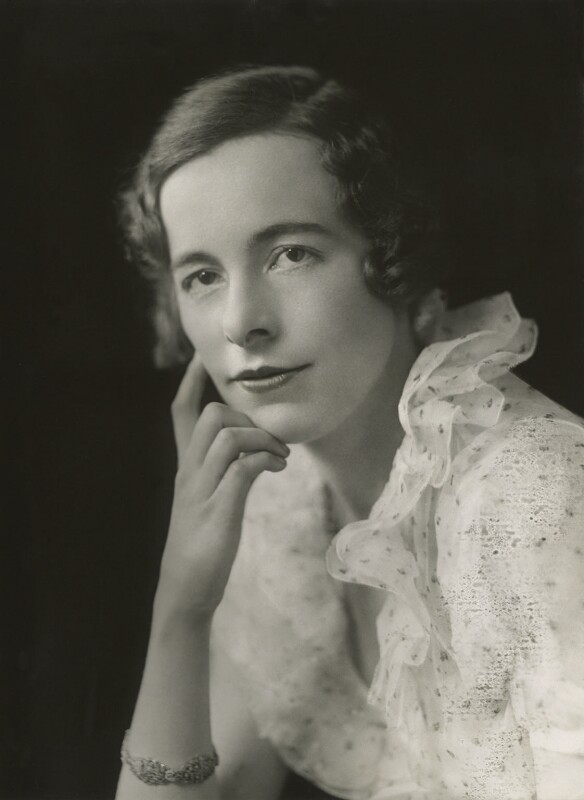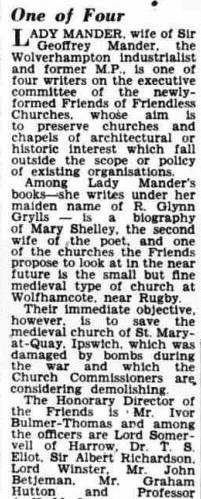
Published: 05/03/2021
Updated: 08/03/2022
The Friends of Friendless Churches was founded by a group of historians, artists, and writers, including Lady Mander of Wightwick Manor, a noted biographer and keen conservationist.
Several Victorian and Edwardian churches in our care were also founded by women. Some were built in response to the loss of loved ones, while others were inspired by the experiences of war. They have left a legacy of glorious and diverse Arts & Crafts places of worship — from a peaceful Catholic chapel in the Cotswolds, to a little piece of Italy in the Welsh countryside.
Women have also been at the forefront of fundraising efforts that have maintained and enhanced the buildings now in our care, and helped forge the communities that thrived around them.
Here are some of their stories.

Rosalie Glynn Mander nee Grylls (1905-1988) was a British biographer, lecturer and Liberal Party politician. After graduating with a Master in Arts from Lady Margaret Hall, Oxford, she became Secretary to the Liberal MP Edgar Granville. In July 1930 she was selected as Liberal prospective parliamentary candidate for the Reading Division of Berkshire for 1931 General Election. However, by the time of the election a National Government had been formed, and she didn’t stand again.
In 1930, she married Liberal MP Geoffrey Mander. Mander was chairman of a paint and varnish manufacturers in Wolverhampton, as well as an art collector and parliamentarian. The Manders’ home was Wightwick Manor in Staffordshire. Built in the 1880s, it had been decorated in the latest Arts & Crafts style, including many William Morris furnishings and pre-Raphaelite works of art.
The home must have inspired Rosalie; she became a noted biographer of the Romantics and Pre-Raphaelites, including Dante Gabriel Rossetti and Mary Shelley, and lectured frequently in the United States.
In 1937, the Manders gave Wightwick Manor and its contents to the National Trust; it was the very first house in the conservation charity’s care. They became its live-in curators and continued to add to its collection, including a particularly rich collection of works by women artists. Geoffrey Mander was knighted in 1945, and Rosalie became Lady Mander.

Birmingham Daily Post, 15 Aug 1957. ©Reach PLC., via BritishNewspaperArchive.co.uk
On 3 July 1957, Ivor Bulmer-Thomas chaired the inaugural meeting of Friends of Friendless Churches at the House of Commons. The founding group included architects, artists, historians, and poets — all men — and Lady Mander.

On 11 April 1894, Louise Janette Anne Richards nee Edwards, a widow of more than 20 years, married recent widower Reverend Charles Tooth at St Paul’s, Knightsbridge.
Charles Tooth had started his career as managing partner of the Tooth brothers’ brewery. Three of his brothers had emigrated to Australia, where they supplied beer to gold prospectors. Charles was even the author of several brewing patents. However, after the company ceased business, Tooth — along with two other brothers — attended Cambridge and was ordained. In 1876, he moved to Sienna for health reasons. He soon founded and became chaplain of St Mark’s English church in Florence.
Meanwhile, Louisa, the wealthy widow of a Welsh magistrate, lived in Chelsea with her mother and children (and numerous servants).
How did Louisa and Charles meet? Did she perhaps take a holiday in Florence and attend church there? Or did they meet in London? We don’t know, but their time together was tragically short. On 2 August 1894, after less than three months of marriage, Rev. Tooth died in Gibraltar.
In his memory, Louisa commissioned the building of a new church — another St Mark’s — but this time, rather than in Italy, it was to be in the hamlet of Brithdir, in Gwynedd. However, Henry Wilson’s glorious Arts and Crafts design, with red ochre walls and a blue ceiling, brought the warmth of Tuscany to the rugged Welsh countryside.

After the foundation stone for St Mark's, Brithdir was laid in a ceremony on 19 October 1895, Louisa hosted lunch at her home — and all were invited! ‘Her kindness and liberality to all good and deserving causes in the district is so well known that her return is welcomed by all alike.’ St Mark’s was consecrated in 1898 and Louisa Tooth died the following year. She was buried at Llanynys but memorial services took place at St Mark’s. The church was ‘very full’ and the service was said to be ‘very pathetic and manifest signs of grief and sorrow were shown’.

In her will of 1899, Mary Barton (nee Nicholas) of Corsley House left £10,000 for the purchase of a piece of land at Temple Corsley and the building and maintenance of a chapel of ease there - in memory of her husband and son. The Bartons had owned land at Corsley since the 18th century, and built Corsley House in a Neoclassical style in 1814.
Mary’s husband, Nathaniel Barton, a magistrate, had died decades earlier. However, their son and only child, known as Fletcher Barton, had only just passed away in January 1899. Fletcher, a J.P., was still a bachelor at 49, but he was engaged to Miss Rose Travers, ‘to whom he states he should assuredly have been married if he had lived.’ He left his estate to his fiancee, with an instruction to also send her the rings and love-letters locked up in his drawers.
Mary followed her son to the grave just nine months later.
Mary Barton’s executors chose W. H. Stanley of Trowbridge as the architect of the ‘Barton Memorial Church’. On 1 Feb 1902 - a ‘rather boistrous and stormy day’ - the Marquis of Bath, using a specially engraved silver trowel, ‘laid the foundation stone of the church which Mrs Barton had decreed should be erected’. He hoped that the gathering for the ceremony would be ‘a remembrance and a memorial of a kind and good family.’

Set in a chocolate-box village in Wiltshire, built from honeyed stone in doll-like proportions, St Mary’s in Temple, Corsley is a tiny masterpiece of Gothic Arts & Crafts style. The chapel was built out of loss and longing, but became a glorious celebration of life, architecture and craft.


In 1897, Louisa Sophia Harris of ‘The Rocks’, Matlock Bath, had had enough. She was already dismayed by the Low churchmanship of the nearby parish church. And now, all she wanted was to install a monument there. The vicar refused.
But, it wasn't quite in accordance with Canon Law to memorialise a dog in a church ... So, Louisa built her own chapel, where she could do as she pleased.
Louisa, wife of a solicitor, commissioned Guy Dawber to design a private chapel on a steep hillside overlooking the Derwent Valley. A picturesque path wound from Louisa’s grand residence to the door of the chapel.
In line with Dawber's ideals, John the Baptist's chapel in Matlock Dale appears as an extension of the natural rocky cliff face. At the base, a water-filled stone tank was added — Mrs Harris’s act of consideration towards the horses pulling their carts up the steep hill.
The church was dedicated to Louisa’s aunt and uncle, Louisa and John Greaves. However, right at the back of Louisa’s treasure house is a small brass memorial engraved to her beloved pet: ‘In most loving memory of Vida. L.S.H. Till the last and brightest Easter Day be born’.

Louisa died in 1908 and her funeral service was held at St John’s. In her will she bequeathed the chapel to the Rector of Matlock to be used by the Church of England, leaving £10,000 to help care for it.
Passionate in her care for animals, Louisa also left £1,000 each to the RSPCA and Battersea Dogs' Home.


Bertha Kessler and Katherine Hudson were members of the First Aid Nursing Auxiliary in the First World War. However, the trauma of war took its toll and by 1920 both women were under psychiatric care.
A few years later, having recovered, Bertha and Katherine attended a service by W. E. Orchard, which was transformative... “after a 49 minute address… a curtain was drawn back and we were gazing at an altar ablaze with 40 candles… a procession of choristers entered … amid a cloud of incense.
The two women converted to Catholicism and decided to devote their lives to the ministry of spiritual healing. The peace of the English countryside beckoned … and they settled on the Stroud Valleys of Gloucestershire, where in 1927, they acquired the Victorian house of Templewood (then called Tanglewood) at Brownshill.
Kessler and Hudson used their own meagre savings to build St Mary of the Angels on Brownshill overlooking the Golden Valley. Despite the modesty of the budget, they went to the best: W.D. Caröe, who was architect to the Ecclesiastical Commissioners and to a number of cathedrals.
By the time Bertha and Katherine came to him he was 73 and he died a year after its consecration in 1937. It mixes styles with a vengeance – “Romanesque with a hint of Baroque” says Alan Brooks in the Pevsner volume. Inside the view east is dominated by a huge Neo-Norman chancel arch whilst to the west there is a gallery with Swedish echoes.

Close by they established a convent and gathered a Catholic community. They bought several properties in the village and were devoted to caring for those suffering from post-traumatic stress disorder. They strove “to make each house a home where the members find support, help and consolation in their distress”.
In 1946, their work was severely tested when an RAF bomber landed on Templewood house.
Bertha and Katherine died within three weeks of each other in 1963. They are buried side-by-side under simple crosses in the Brownshill churchyard.


**Welcome to the Bazaar!** exclaimed the banner that greeted visitors to Corse House & Gardens in Laugharne on 3rd May, 1882. They had come for the grand bazaar and garden fete hosted by Mrs Abra Hughes Wienholt (nee Skyrme), wife of the J.P. of Carmarthen. Her mission — to raise funds to rescue Llandawke's church, which at the time “resembled a barn more than a House of God”.
The day started ominously with morning showers, but then the azure sky appeared, and the sun shone out in warmth and glory. As two brass bands played, some more adventurous spirits attempted to dance on the wet ground. Around them, a goodly display of bunting lent a most charming and pleasing effect to the scene.
Laugharne's ladies had come out in force to support the cause, with the town's most eminent women presiding over stalls.
The local newspaper reported the day in detail: Mrs Norton of Laugharne Castle had Stall 1, which boasted terracotta, medallions of stuffed birds, rare vases and a beautiful model of a ship fully-rigged. Mrs Wienholt herself ran Stalls 2, 3, and 4 – which had the most rich and handsome display of every description … including richly attired dolls – dolls in cradles, dolls in chairs, dolls everywhere! Other stalls offered a 3-foot tall doll (more dolls!), books on the history of Grecian sculpture, and of course, some refreshments ('cups of cheer').
By September, work at the church was complete, and it reopened to reveal this robustly carved oak altar, crafted not by a carpenter, but by local stone mason Owen Williams. From his imagination and skilled hands sprang vine-wrapped tracery, two sheep with a shepherd's crook, doves with olive branches, angels, and an assortment of flowers – lily of the valley, passionflower and rose of Sharon.
The altar and all of the work in the chancel was paid for by Mrs Wienholt. Without the funds raised by the enterprising Ladies of Laugharne at their grand bazaar, St Odoceus's, Llandawke and its splendid altar may not be with us today.
